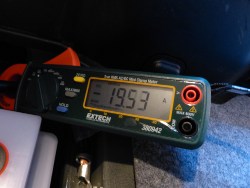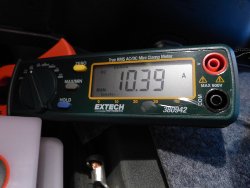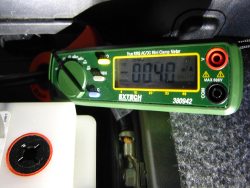Sunday, December 8, 2013
When I left the car with the new battery installed and the Battery Minder activated I thought that would be the end of my battery troubles but I was wrong. I dropped by the garage a few days later and found the Battery Minder status indicators showing “Battery Weak” and the unit still in charging mode, not maintenance mode as expected. A VOM check revealed, annoyingly, that my brand new battery was fully discharged at 11.9 volts. That could mean only one thing – a high parasitic load overwhelmed the charger and was likely responsible for destroying the old battery, not simply old age as I originally assumed.
I took the battery home to charge it while I researched the problem. After charging the battery for over 12 hours at the 8A setting the Battery Minder entered maintenance mode. Reading the forums I found the most likely causes for a parasitic load were the aux fan speed controller and the HVAC blower Final Stage Unit, or FSU. The trick would involve finding the errant load by baselining the current consumption with the car in various states and then pull fuses in an attempt to witness which circuit causes the current to drop to expected levels. While I knew that the car would enter power conservation mode (i.e. sleep mode) about 20 minutes after the doors are locked I had no idea what the quiescent current would or should be. According to the forums it's roughly 40-60mA.
Clearly my car was drawing more than that but I didn't know exactly how much so I decided to utilize a piece of test equipment, the Extech 380942 clamp meter, to find out. This unit reads up to 30 amps DC without breaking the circuit and unlike some meters with higher current ratings sports a milliamp scale for greater accuracy at lower current readings. Incidentally, I briefly considered using my Fluke 87V for this task but quickly ruled that out for two reasons -- first, it would require me to place the meter inline with one of the battery cables...a process that just begs for arc faults, and second, from my observations in my technician's maintenance bay I knew the circuit would be subject to high loads (20+ amps) with the engine off. And, of course, starting the engine would be absolutely out of the question, since that draws hundreds of amps.
Placing the clamp meter around the ground wire at the battery I measured approximately 3.9A shortly after I installed and reconnected the freshly charged battery. That dropped to 2.7A when I disabled both trunk lights, thus proving each light consumes around 0.6A. As I turned the key to position one the instrumentation came alive and the fuel pump turned on for a few moments, causing the current to spike to roughly 20 amps before settling at 15A. Turning the key to start the engine I noticed the current turn positive, indicating a charge rate of 10A, which is about what I would have expected based on my experience with other charging systems.
I took the vehicle out on my usual test loop in an attempt to check the HVAC blower motor operation (and hence the health of the FSU and HVAC control unit) as well as the aux fan. The HVAC controls responded as expected, the heat worked, and the fan operated at all speeds. I drove the car long enough to get the coolant and oil temperature up to normal and even let the engine idle a bit after I got back to the garage but I never did hear the aux fan run. If I'd been driving in summer weather this would be a huge red flag but I know from my work on the E36 that it's unlikely to hear the aux fan run in the winter months so I discounted this result.
After I pulled the car back into the garage I turned off the key, opened the trunk, locked the doors and waited about 15 minutes for the car to enter sleep mode. When the transmission position indicator on the center console extinguished I noticed the current dropped to roughly 590mA (0.6A). While this was nearly 10 times the maximum expected current it seemed too low to have drained the battery in only a few days so I decided to restart the charging cycle and come back the next day to begin pulling fuses one by one in an attempt to ferret out the problem circuit.
Returning the next day I fully expected to see the Battery Minder "Battery Weak” annunciator illuminated. Instead I found the charger in maintenance mode, meaning that the problem I'd seen earlier had mysteriously disappeared and the high parasitic drain along with it. To confirm my findings I removed the charger and tested the battery to find a strong 13.7 volts, while the current had dropped to an expected 40mA as measured on the Extech meter in the milliamp scale. To wrap things up I attached the charger again, reset the charging parameters and waited a few minutes to see if the charger would again recognize the battery as fully charged and enter maintenance mode. Sure enough, that's what happened.
At this point I felt it was safe to leave the vehicle with the charger attached, and not a moment too soon, as snow began to fall in advance of a small storm that promised to leave the first accumulating snow of the season. I plan to keep a close watch over the battery for the next few weeks. If the problem doesn't reappear I'll attribute this to the completely plausible idea that the car was angry at me for neglecting her all these months. Sorry honey, I didn't mean it. I promise!
Mileage: 15810






